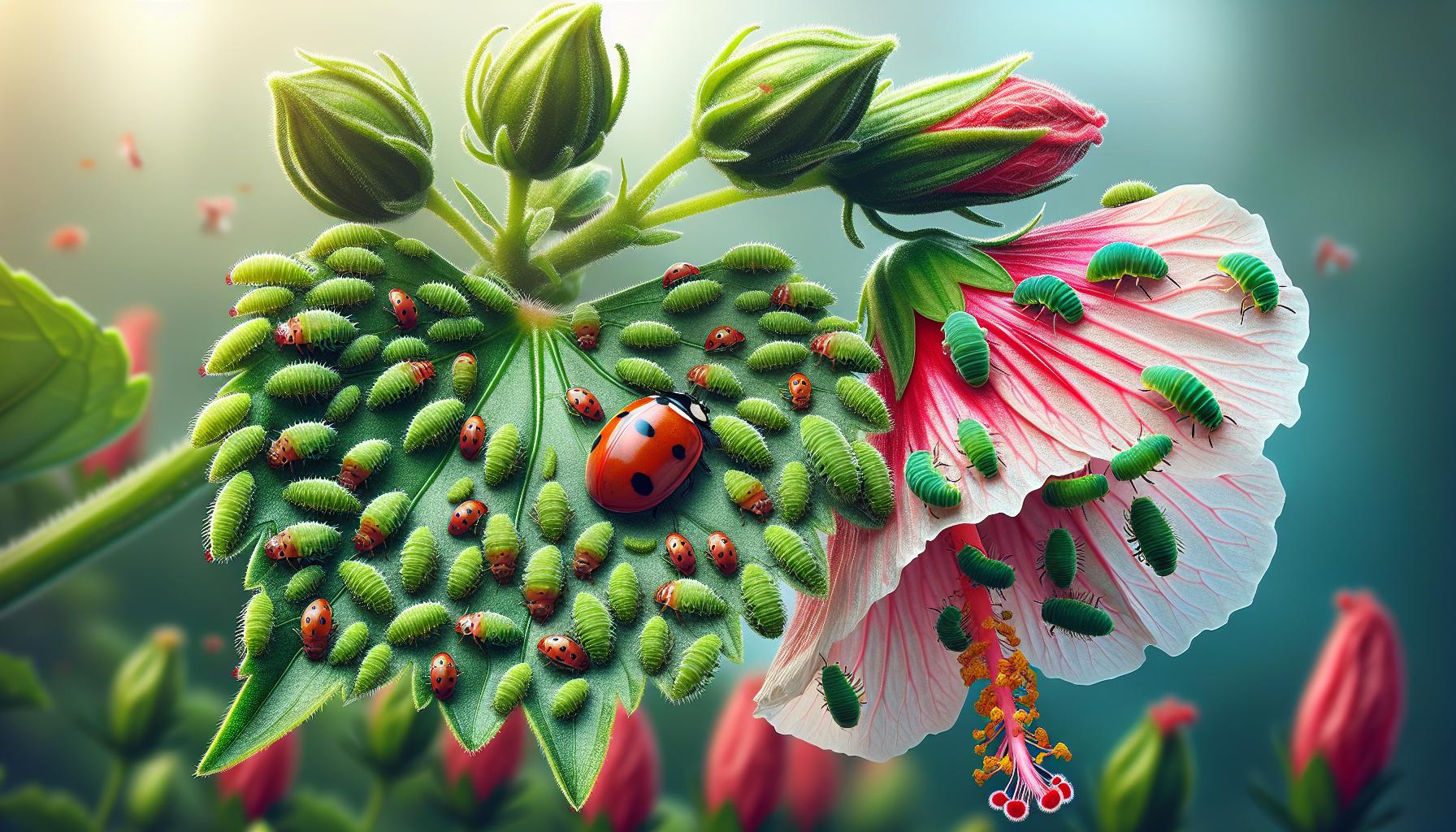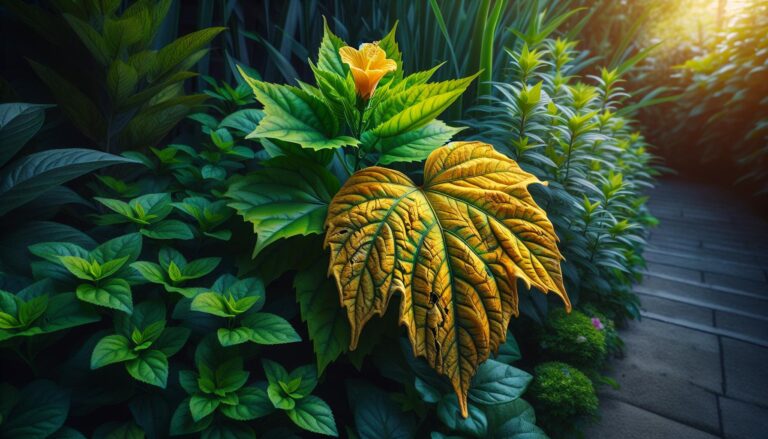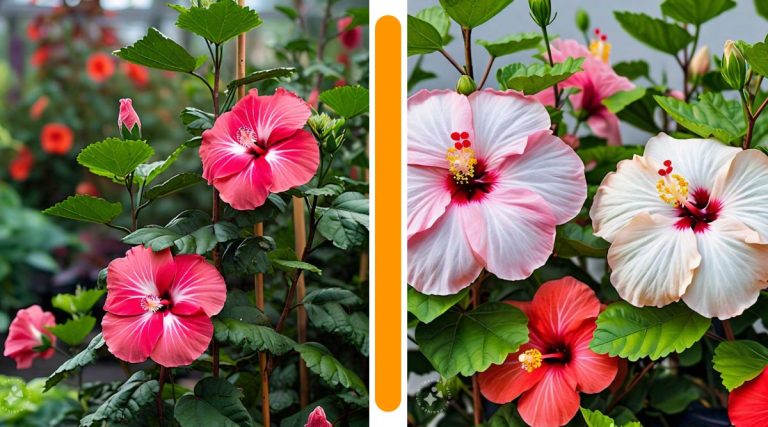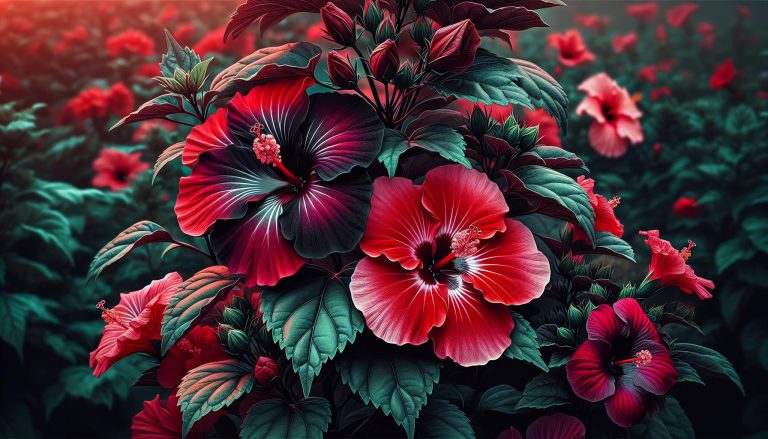Aphids on Hibiscus: Natural Control and Prevention Tips for Healthy Plants
As a passionate gardener, I’ve encountered my fair share of plant pests. But few are as persistent and troublesome as aphids on hibiscus. These tiny sap-sucking insects can quickly turn a vibrant, healthy hibiscus into a wilting, distressed plant.
Have you noticed your hibiscus leaves curling or yellowing? Or perhaps you’ve spotted a sticky substance on the leaves and stems? These could be telltale signs of an aphid infestation. While these pests may seem harmless due to their small size, they can cause significant damage if left unchecked. But don’t worry – with the right knowledge and techniques, you can effectively manage and prevent aphid infestations on your beloved hibiscus plants.
Understanding Aphids: The Tiny Pests on Hibiscus Plants
Aphids are small, soft-bodied insects that commonly infest hibiscus plants. These pests, measuring 1/16 to 1/8 inch long, come in various colors including green, yellow, brown, and black. I’ve observed that aphids cluster on new growth, buds, and the undersides of leaves, where they feed on plant sap.
Identification of Aphids
Identifying aphids on hibiscus plants is crucial for effective control. Here are key characteristics to look for:
- Pear-shaped bodies
- Long antennae
- Two tube-like structures (cornicles) on their rear
- Wingless or winged forms
- Tendency to gather in dense colonies
Life Cycle and Reproduction
Aphids have a rapid reproduction cycle, allowing populations to explode quickly:
- Females give birth to live young without mating
- Nymphs mature in 7-10 days
- A single aphid can produce up to 80 offspring in a week
This reproductive efficiency explains why aphid infestations can appear seemingly overnight on hibiscus plants.
Damage Caused by Aphids
Aphids harm hibiscus plants in several ways:
- Sap extraction weakens plants
- Leaf distortion and yellowing
- Stunted growth
- Transmission of plant viruses
- Attraction of other pests like ants
The honeydew excreted by aphids also promotes sooty mold growth, further compromising plant health.
Natural Predators of Aphids
Several beneficial insects prey on aphids, providing natural pest control:
- Ladybugs
- Lacewings
- Parasitic wasps
- Hoverflies
Encouraging these predators in your garden can help manage aphid populations on hibiscus plants.
Identifying Aphid Infestations on Hibiscus

Identifying aphid infestations on hibiscus plants is crucial for effective pest management. I’ll guide you through the common signs of aphid presence and the specific types of aphids that affect hibiscus plants.
Common Signs of Aphid Presence
Recognizing aphid infestations early helps prevent extensive damage to hibiscus plants. Here are key indicators:
- Curled or distorted leaves
- Sticky residue (honeydew) on leaves or stems
- Presence of sooty mold fungus
- Yellowing or wilting of leaves
- Stunted growth or deformed buds
- Visible clusters of small, pear-shaped insects
- Ants marching up and down the plant (attracted to honeydew)
When examining hibiscus plants, I focus on the undersides of leaves and new growth areas where aphids commonly congregate.
Types of Aphids Affecting Hibiscus
Several aphid species target hibiscus plants, each with distinct characteristics:
- Cotton Aphid (Aphis gossypii)
- Size: 1-2 mm long
- Color: Varies from yellow to dark green
- Distinctive feature: Black cornicles (tube-like structures on the abdomen)
- Melon Aphid (Aphis gossypii)
- Size: 1-1.5 mm long
- Color: Light green to dark green or black
- Distinctive feature: Short antennae and cornicles
- Green Peach Aphid (Myzus persicae)
- Size: 1.2-2.1 mm long
- Color: Pale yellow-green to pink or red
- Distinctive feature: Long antennae and visible cauda (tail-like appendage)
- Potato Aphid (Macrosiphum euphorbiae)
- Size: 1.7-3.6 mm long
- Color: Green or pink
- Distinctive feature: Long legs and antennae
Identifying the specific aphid species helps tailor treatment methods and understand potential risks to hibiscus plants.
The Impact of Aphids on Hibiscus Health
Aphids pose significant threats to hibiscus plants, compromising their overall health and appearance. Their feeding habits and reproductive cycles can lead to severe damage if left unchecked. Let’s explore the specific ways aphids impact hibiscus health.
Damage to Leaves and Stems
Aphids cause extensive damage to hibiscus leaves and stems through their feeding activities. They pierce plant tissues with their needle-like mouthparts, extracting sap and nutrients. This feeding behavior results in:
- Curled, distorted leaves
- Yellowing or chlorotic spots on foliage
- Stunted growth of new shoots
- Weakened stems and branches
- Reduced flower production
As aphid populations grow, they excrete honeydew, a sticky substance that coats leaves and stems. This honeydew often leads to sooty mold growth, further impeding photosynthesis and plant health.
Potential Transmission of Plant Viruses
Aphids are notorious vectors for plant viruses, posing a severe threat to hibiscus health. Their feeding habits facilitate the spread of various viral diseases:
- Hibiscus chlorotic ringspot virus (HCRSV)
- Hibiscus latent ringspot virus (HLRSV)
- Cotton leaf curl virus (CLCuV)
These viruses can cause:
- Leaf mottling and discoloration
- Stunted growth and deformed leaves
- Reduced flower production
- Overall plant decline
Aphids acquire viruses from infected plants and transmit them to healthy hibiscus during feeding, potentially affecting entire gardens or nurseries. Early detection and management of aphid populations are crucial to prevent the spread of these harmful plant viruses.
Natural Methods for Controlling Aphids on Hibiscus
Natural methods offer effective and environmentally friendly solutions for controlling aphids on hibiscus plants. These approaches harness nature’s own mechanisms to combat aphid infestations without relying on harsh chemicals.
Beneficial Insects as Predators
Beneficial insects are natural predators that feed on aphids, providing an eco-friendly pest control solution. I’ve found ladybugs, lacewings, and parasitic wasps to be particularly effective in managing aphid populations on hibiscus plants. Ladybugs consume up to 50 aphids per day, while lacewing larvae can devour 200 aphids weekly. To attract these helpful insects:
- Plant nectar-rich flowers like marigolds, cosmos, and sweet alyssum near hibiscus
- Avoid using broad-spectrum insecticides that harm beneficial insects
- Create insect habitats by leaving some areas of the garden undisturbed
- Purchase beneficial insects from garden centers for quick population establishment
Organic Remedies and Sprays
Organic remedies and sprays offer targeted aphid control without the risks associated with synthetic pesticides. I’ve successfully used these natural solutions to combat aphid infestations on hibiscus:
- Neem oil spray: Mix 1 tablespoon neem oil with 1 quart water and apply weekly
- Insecticidal soap: Combine 1 tablespoon liquid soap with 1 quart water, spray directly on aphids
- Garlic spray: Blend 2 garlic cloves with 1 quart water, strain and apply to affected areas
- Diatomaceous earth: Sprinkle around plant base to deter crawling aphids
- Essential oil spray: Mix 4-5 drops of peppermint, rosemary, or thyme oil with 1 cup water
Apply these remedies in the early morning or late evening to avoid leaf burn. Repeat applications every 5-7 days until aphid populations are under control.
Chemical Solutions for Severe Aphid Infestations
When natural and organic methods aren’t enough to control severe aphid infestations on hibiscus plants, chemical solutions can be effective. I’ll discuss several chemical options that target aphids while minimizing harm to beneficial insects and the environment.
Systemic Insecticides
Systemic insecticides are absorbed by the plant and distributed throughout its tissues, making them effective against sap-sucking pests like aphids.
- Imidacloprid: Applied as a soil drench or foliar spray
- Acetamiprid: Available in granular or liquid form
- Dinotefuran: Effective for both indoor and outdoor hibiscus plants
Apply these products according to the manufacturer’s instructions, typically every 4-6 weeks during the growing season.
Contact Insecticides
Contact insecticides kill aphids on direct contact and are useful for quick knockdown of large populations.
- Pyrethrins: Derived from chrysanthemum flowers, fast-acting but short-lived
- Malathion: Broad-spectrum insecticide, use with caution
- Bifenthrin: Provides residual control for up to 4 weeks
Apply these products in the early morning or late evening to minimize impact on pollinators.
Insect Growth Regulators (IGRs)
IGRs disrupt the aphids’ life cycle, preventing them from reaching maturity and reproducing.
- Pyriproxyfen: Effective against nymphs and eggs
- Azadirachtin: Derived from neem oil, interferes with molting process
Use IGRs in combination with other methods for comprehensive aphid control.
Precautions and Best Practices
When using chemical solutions for aphid control on hibiscus:
- Read and follow label instructions carefully
- Rotate between different chemical classes to prevent resistance
- Spot-treat affected areas rather than blanket-spraying the entire plant
- Avoid applying during flowering to protect pollinators
- Wear protective gear, including gloves and a mask, during application
By using these chemical solutions judiciously and in combination with natural methods, you’ll effectively manage severe aphid infestations on your hibiscus plants.
Preventing Future Aphid Attacks on Hibiscus
To prevent future aphid infestations on hibiscus plants, I’ll focus on proactive measures that create an unfavorable environment for these pests. Here are effective strategies to keep aphids at bay:
Regular Inspection
I make it a habit to inspect my hibiscus plants weekly for signs of aphids. This includes:
- Examining the undersides of leaves
- Checking new growth and buds
- Looking for sticky residue on leaves or nearby surfaces
Early detection allows for prompt intervention, preventing small aphid populations from exploding into full-blown infestations.
Proper Plant Care
Maintaining healthy hibiscus plants is crucial for aphid prevention. I ensure:
- Adequate watering without overwatering
- Proper fertilization to avoid excess nitrogen
- Pruning to improve air circulation
- Removing dead or diseased plant material promptly
Healthy plants are more resistant to aphid attacks and can better withstand minor infestations.
Companion Planting
I strategically plant companion plants near my hibiscus to deter aphids:
| Companion Plant | Benefits |
|---|---|
| Marigolds | Repel aphids with their strong scent |
| Nasturtiums | Act as trap crops, attracting aphids away from hibiscus |
| Chives | Emit a strong odor that confuses and repels aphids |
| Garlic | Contains sulfur compounds that deter aphids |
These plants not only help prevent aphid infestations but also add beauty and diversity to my garden.
Barrier Methods
I use physical barriers to protect my hibiscus plants:
- Installing row covers or fine mesh netting
- Applying reflective mulch around the base of plants
- Creating sticky barriers on plant stems
These methods prevent aphids from reaching and colonizing hibiscus plants.
Maintain Beneficial Insect Populations
Encouraging natural predators is an effective long-term strategy. I:
- Plant diverse flowering species to attract beneficial insects
- Provide water sources for beneficial insects
- Avoid broad-spectrum pesticides that harm beneficial insects
Ladybugs, lacewings, and parasitic wasps are particularly effective at controlling aphid populations.
Regular Cleaning
I maintain a clean garden environment to reduce the likelihood of aphid infestations:
- Removing plant debris and fallen leaves
- Cleaning gardening tools regularly
- Disposing of infested plant material properly
These practices eliminate potential hiding spots and breeding grounds for aphids.
By implementing these preventive measures, I significantly reduce the risk of future aphid attacks on my hibiscus plants. This proactive approach not only protects my plants but also promotes a healthier, more balanced garden ecosystem.
Conclusion
Protecting your hibiscus from aphids doesn’t have to be a daunting task. By implementing a combination of natural controls preventive measures and targeted treatments you can keep these pesky insects at bay. Remember that consistency is key in managing aphid populations.
I encourage you to regularly inspect your plants and act quickly at the first sign of infestation. With the right approach you’ll be able to enjoy beautiful healthy hibiscus blooms all season long. Don’t let aphids discourage you – armed with these strategies you’re well-equipped to win the battle against these garden pests.







